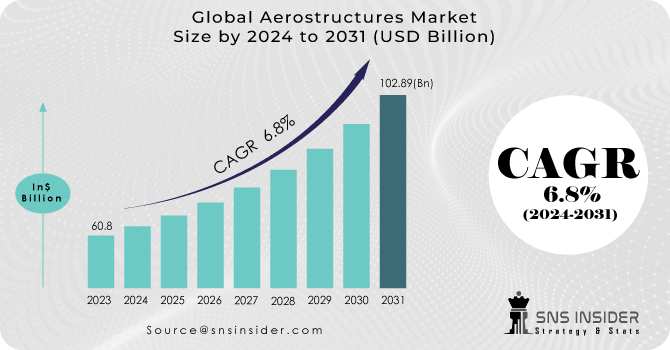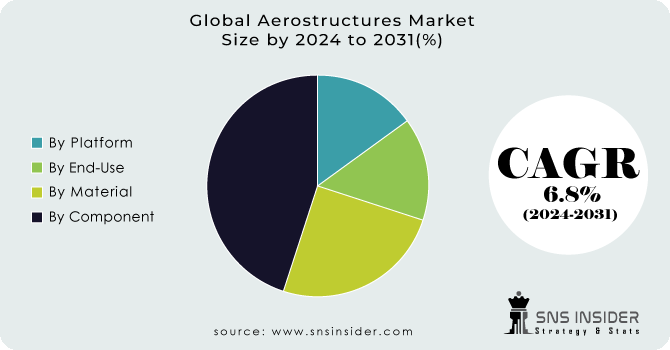Aerostructures Market Report Scope & Overview:
The Aerostructures Market Size was valued at USD 60.8 billion in 2023 and is expected to reach USD 109.9 billion by 2032 and grow at a CAGR of 6.8% over the forecast period 2024-2032.
This market is one of the essential pieces of the airframe or the plane's body. Aerostructures are made up of all the parts that help an airplane fly and keep it running smoothly as well as withstand the streamlined powers. It incorporates the wings, fuselages, stimulus structures, and flight control surfaces. The Aerostructure market is becoming a direct result of the rising necessity for new planes close by the particular premium for a couple of additional parts. The Aerostructures Market Organizations are making aerostructures basically for business planes all around the planet.

To get more information on Aerostructures Market - Request Free Sample Report
Throughout the long term, the rising number of voyagers is enabling Aerostructures Organizations to create aerostructures and driving the flight equipment market. Also, Aviation Producers are embracing new systems to work on the introduction of a plane, and the gathering of aerostructures is growing. The improvement of composite materials for gathering planes is invigorating the advancement of the market.
Progression of development has allowed makers to sort out the mischief to materials and access the plan of the airplane with the use of the PC or Infrared light to get to the strength and execution. The Aerostructures Market execution of the system can be assessed with these tests as the aerostructures expect a fundamental part in plane working. The aerostructures are indispensable, from helicopters and competitor planes to voyagers and business streams. The military is taking care of a huge boatload of cash to redesign the plane task force's capacity to fight, size, & strength.
Aerostructures are the parts of an aircraft's airframe that make up the whole frame or body. The fuselage, nacelle, and nose of an airplane are all components of the airframe that are capable of flight. Quick development and extension of key market players and expanded air travel present pandemic are normal to help the worldwide aerostructures market development in the conjecture period.
The airframe comprises parts like the nose, wings, nacelle and arch, fuselage, and landing stuff and entryways. This large number of parts combine to make the fundamental structure of an Airplane. Different airplane comprises different airframes, designs, and parts. Any aerostructure is a gathering of a few underlying individuals developed fundamentally from one or the other or the accompanying materials as a whole: amalgams, metals, and composites.
The utilization of composites and other high-level materials in aerostructures have prompted extremist plan changes in airplane plans. The aircraft's fuel efficiency has been improved as a result of the significant weight savings caused by their inherent high strength-to-weight ratio. Arising innovations like added substance producing and Mechanized Fiber Arrangement strategies are upgrading the extent of incorporating progressed materials into complex part plans, while additionally diminishing the airplane's time required to circle back.
MARKET DYNAMICS
DRIVERS
-
Aerostructure demand is intimately related to the manufacture & sale of commercial or military aircraft.
-
Fuel Efficiency and Lightweight Materials is the driver of the Aerostructures Market.
Aerostructures producers are ceaselessly endeavoring to make airplanes eco-friendlier and more harmless to the ecosystem. This prompts the utilization of lightweight materials like composites and progressed combinations, which require imaginative aerostructure plans.
RESTRAIN
-
Manufacturing aerostructures typically involves high labour and material costs, particularly for advanced materials like titanium and composites.
-
The cyclical Nature of the Aerospace Industry is the restraint of the Aerostructures Market.
Due to its cyclical nature, the aerospace industry can be affected by economic downturns. During financial downturns, carriers might defer or drop aeroplane orders, prompting diminished interest in aerostructures.
OPPORTUNITY
-
Numerous nations are modernizing their tactical armadas, which incorporates the improvement of cutting-edge military aeroplanes.
-
Rising Global Air Travel is an opportunity for the Aerostructures Market.
The development of the working class in developing business sectors and the rising reasonableness of air ventures have prompted rising interest in business aeroplanes. Aerostructures producers have the potential chance to take care of this developing business sector.
CHALLENGES
-
In the aerospace industry, materials, labour, and technology development can be expensive.
-
Economic Uncertainty is the challenge of the Aerostructures Market.
The avionic business is delicate to financial changes, and slumps can prompt diminished interest in new aeroplanes and aerostructures, influencing makers' incomes and benefits.
IMPACT OF RUSSIAN RUSSIAN-UKRAINE WAR
The attack on Ukraine has had sweeping consequences for the avionics and the aeroplane business, with Russia customarily one of the biggest providers of unrefined components. It has the biggest normal stores on the planet and had one of the biggest platinum holds worldwide in 2020. In 2020, Russian companies exported unprocessed platinum worth over $8.51 billion, nickel worth $8.1 billion, and aluminium worth $7.01 billion. Simultaneously, Russia was likewise a significant exporter of oil and gas, sending out more than $200 billion of oils, and oil items.
The attack in mid-2022 has upset basic stockpile chains in the avionics and aviation space. This has caused serious overabundances for aeroplane conveyances and a shortage of extras. Airbus authorities gauge that this store network issue will go on through 2023 and have cut attaches with Russian providers as end of 2022.
IMPACT OF ONGOING RECESSION
Compared to many other industries, such as retail, software, e-commerce, fintech, and so on, the aerospace industry typically has a much longer business cycle. Truth be told, the airplane business has quite recently escaped the downturn, after the pandemic. It is at present on the rise and expected to keep on seeing a rising business sector for quite a while. We are proceeding to screen what is happening, notwithstanding, from the general aeroplane business viewpoint or according to the market viewpoint, we see no close-term disturbing signs.
The aeronautic trade, containing exploration, improvement, and assembling of the whole range of frameworks, hardware and gear for both common and safeguard sections, is at present seeing a rise universally and is probably not going to see any disturbing indications of the downturn, Asia Pacific, Eaton, Aviation Gathering, a Dublin-based shrewd power the executive’s organization that revealed yearly income in overabundance of $21-22 billion out of 2022. In an ongoing recession, the Aerostructures Market is gaining profit up to 1.5-1.8%.
KEY MARKET SEGMENTATION
By Component
-
Nacelle and Pylon
-
Fuselage
-
Wings
-
Flight Control Surfaces
-
Nose
-
Others
By Material
-
Metals
-
Alloys
-
Composite
By End-Use
-
Aftermarket
-
OEM
By Platform
-
Rotary Wing
-
Fixed Wing

Need any customization research on Aerostructures Market - Enquiry Now
REGIONAL COVERAGE:
North America
-
US
-
Canada
-
Mexico
Europe
-
Eastern Europe
-
Poland
-
Romania
-
Hungary
-
Turkey
-
Rest of Eastern Europe
-
-
Western Europe
-
Germany
-
France
-
UK
-
Italy
-
Spain
-
Netherlands
-
Switzerland
-
Austria
-
Rest of Western Europe
-
Asia Pacific
-
China
-
India
-
Japan
-
South Korea
-
Vietnam
-
Singapore
-
Australia
-
Rest of Asia Pacific
Middle East & Africa
-
Middle East
-
UAE
-
Egypt
-
Saudi Arabia
-
Qatar
-
Rest of Middle East
-
-
Africa
-
Nigeria
-
South Africa
-
Rest of Africa
-
Latin America
-
Brazil
-
Argentina
-
Colombia
-
Rest of Latin America
REGIONAL ANALYSIS
North America: North America is assessed to represent the most elevated Vehicle in the anticipated period. The rising interest in business aeroplanes is significantly driving this development of the market. The US and Canada are the nations concentrated under this district. The presence of driving aerostructure producers and expanding R & D ventures is impacting development in this portion.
Asia Pacific: The Center East and Africa district will develop outstandingly during the figure time frame, inferable from expanding drives by the public authority and worldwide market players entering the market. An ascent in military spending, developing interest, rising organizations with worldwide players, and the rising business jets market is supposed to help the market development.
Key players
Some major key players in the Aerostructures Market are Airbus SE, Saab AB, GKN pic, Bombardier Inc, AAR Corp, Spirit AeroSystems Inc., Leonardo S.P.A, Raytheon Technologies Corporation, Triumph Group Inc., Elbit Systems Ltd., and other players.
Airbus SE-Company Financial Analysis

RECENT DEVELOPMENT
In 2023: Soul AeroSystems Inc. What's more, Joramco have consented to an arrangement to be a soul-approved support, fix, and redesign (MRO) focus. Under this arrangement, they will initially give nacelle administrations to particular players and their items.
In 2022: Airbus SE reported the expansion of its agreement with Axiscades Advancements Ltd. to give designing administrations to the plan and improvement of Airbus airplane programs. The agreement will give designing administrations and item advancement for fuselage and wings in various areas.
In 2022: Soul AeroSystems Inc. got an agreement from The Boeing Organization to give even stabilizers to its KC-135R Stratotankers utilized by the US Airforce.
| Report Attributes | Details |
| Market Size in 2023 | US$ 60.8 Billion |
| Market Size by 2032 | US$ 109.9 Billion |
| CAGR | CAGR of 6.8% From 2024 to 2032 |
| Base Year | 2023 |
| Forecast Period | 2024-2032 |
| Historical Data | 2020-2022 |
| Report Scope & Coverage | Market Size, Segments Analysis, Competitive Landscape, Regional Analysis, DROC & SWOT Analysis, Forecast Outlook |
| Key Segments | • By Component (Nacelle and Pylon, Fuselage, Wings, Flight Control Surfaces, Nose, Others) • By Material (Metals, Alloys, Composite) • By End-Use (Aftermarket and OEM) • By Platform (Rotary Wing and Fixed Wing) |
| Regional Analysis/Coverage | North America (US, Canada, Mexico), Europe (Eastern Europe [Poland, Romania, Hungary, Turkey, Rest of Eastern Europe] Western Europe] Germany, France, UK, Italy, Spain, Netherlands, Switzerland, Austria, Rest of Western Europe]), Asia Pacific (China, India, Japan, South Korea, Vietnam, Singapore, Australia, Rest of Asia Pacific), Middle East & Africa (Middle East [UAE, Egypt, Saudi Arabia, Qatar, Rest of Middle East], Africa [Nigeria, South Africa, Rest of Africa], Latin America (Brazil, Argentina, Colombia Rest of Latin America) |
| Company Profiles | Airbus SE, Saab AB, GKN pic, Bombardier Inc, AAR Corp, Spirit AeroSystems Inc., Leonardo S.P.A, Raytheon Technologies Corporation, Triumph Group Inc., Elbit Systems Ltd. |
| Key Drivers | • Aerostructure demand is intimately related to the manufacture & sale of commercial or military aircraft. • Fuel Efficiency and Lightweight Materials is the driver of the Aerostructures Market. |
| Market Opportunity | • Numerous nations are modernizing their tactical armadas, which incorporates the improvement of cutting-edge military aeroplanes. • Rising Global Air Travel is an opportunity for the Aerostructures Market. |

